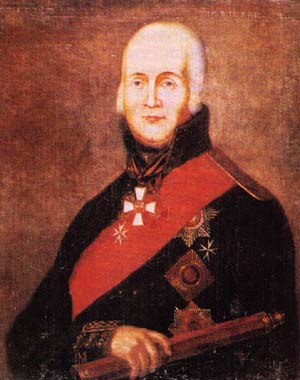The directory «Plots of stamps in the catalogue»
Ushakov (Óøàêîâ) Fyodor Fyodorovich
(1744 or 1745—1817)

Fyodor Ushakov was the most illustrious Russian naval commander and admiral of the 18th century. He was born in the village of Burnakovo in the Government of Yaroslavl, to a modest family of the minor nobility. On February 15, 1761, he signed up for the Russian Navy in Saint Petersburg. After training, he served on a galley in the Baltic Fleet. In 1768 he was transferred to the Don Flotilla and served in the Russo-Turkish War, 1768-1774. He commanded Catherine II's own yacht, and later defended Russian trade ships in the Mediterranean from the British pirate attacks. After Crimea was annexed by the Russians, Ushakov personally supervised the construction of a naval base in Sevastopol and the building of docks in Kherson. During the Second Russo-Turkish War he brilliantly defeated the Turks at Fidonisi, Kerch Strait, and Cape Kalakria. In these battles, he demonstrated the excellence of his innovative, Suvorov-influenced doctrines on art of naval fighting. In 1799, Ushakov was promoted to full admiral and sent to the Mediterranean to support Suvorov's Italian campaign. During this expedition, Ushakov single-handedly carved out the Greek Republic of Seven Islands. He cleared from the French Corfu and all the Ionian islands. His squadron then blocked the French bases in Italy, notably Genoa and Ancona, and successfully assaulted Naples and Rome. Emperor Paul, in his capacity of the Grand Master of the Order of St John, ordered Ushakov to proceed to Malta, which had been besieged by the British to no effect. Admiral Nelson couldn't bear the idea that he would have to follow Ushakov's orders (the Russian commander being his senior in the naval ranks) and suggested that the Russian squadron should be dispatched to Egypt instead. Brewing conflict between the commanders was prevented by Ushakov's being recalled to Russia in 1800, where the new Emperor, Alexander I, failed to appreciate his victories. Ushakov resigned command in 1807 and withdrew into the Sanaksar Abbey in modern-day Mordovia. He was asked to command the local militia during the Patriotic War of 1812 but declined. On March 3, 1944 the Presidium of the Supreme Soviet of the USSR established the Order of Ushakov which, among several other decorations, was preserved in Russia upon the dissolution of the USSR, thus remaining to be one of the highest military awards in the Russian Federation. The Russian Orthodox Church glorified him as a patron saint of the Russian Navy in 2000. His relics are preserved in Sanaksar.
Russia, 1999, Russian Navy near Corfu. Portrait of Ushakov
Ukraine, 2000, Ushakov's flagman ship «St. Paul»
USSR, 1945, Order of Ushakov
USSR, 1987, Fyodor Ushakov and Storming of Corfu
Russia, 1999.02.19,  Moscow. Ship
Moscow. Ship
Russia, 1999,  Russian Navy storming Corfu
Russian Navy storming Corfu
Russia, 2004,  Ribinsk. Ushakov Monument
Ribinsk. Ushakov Monument
USSR, 1959,  Ushakov monument in Kherson
Ushakov monument in Kherson
USSR, 1960,  Ushakov monument in Kherson
Ushakov monument in Kherson
USSR, 1964,  Ushakov monument in Kherson
Ushakov monument in Kherson
Russia, 2008,  Submarine, Order of Ushakov
Submarine, Order of Ushakov
Russia, 2010,  Orders of Ushakov and Kutuzov
Orders of Ushakov and Kutuzov
USSR, 1987.12.15,  Ushakov monument in Kherson
Ushakov monument in Kherson
USSR, 1988.01.18,  Usakov monument in Sevastopol
Usakov monument in Sevastopol